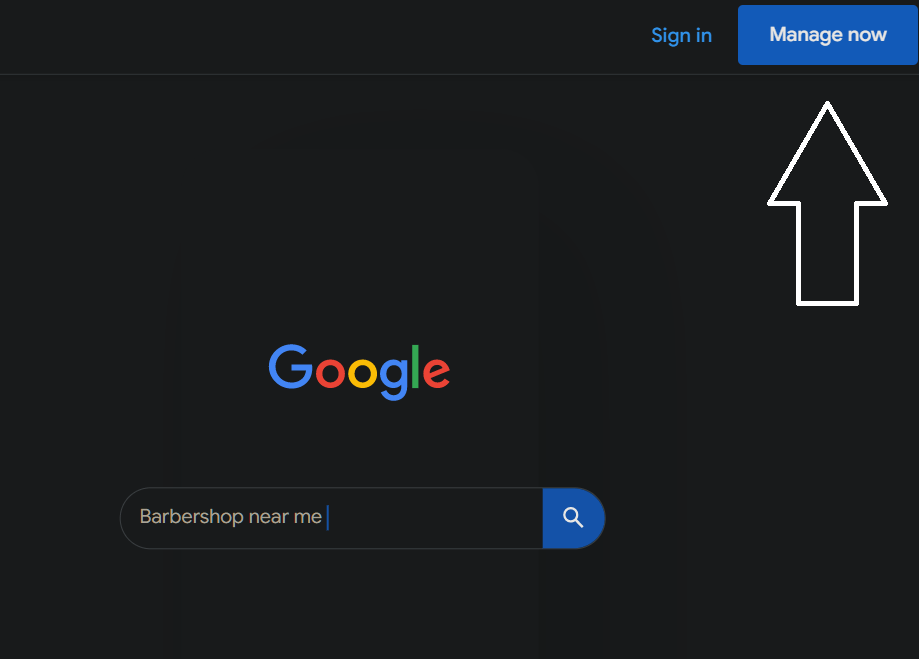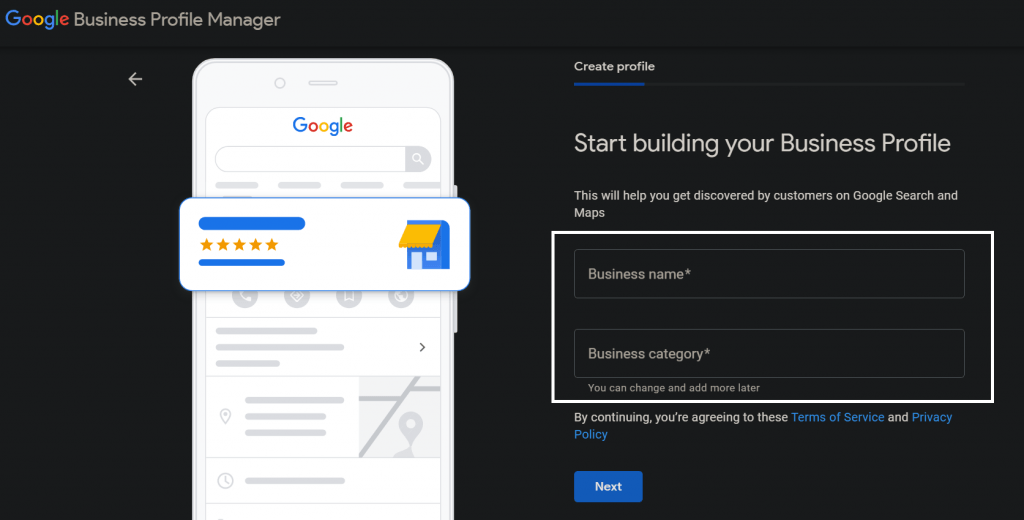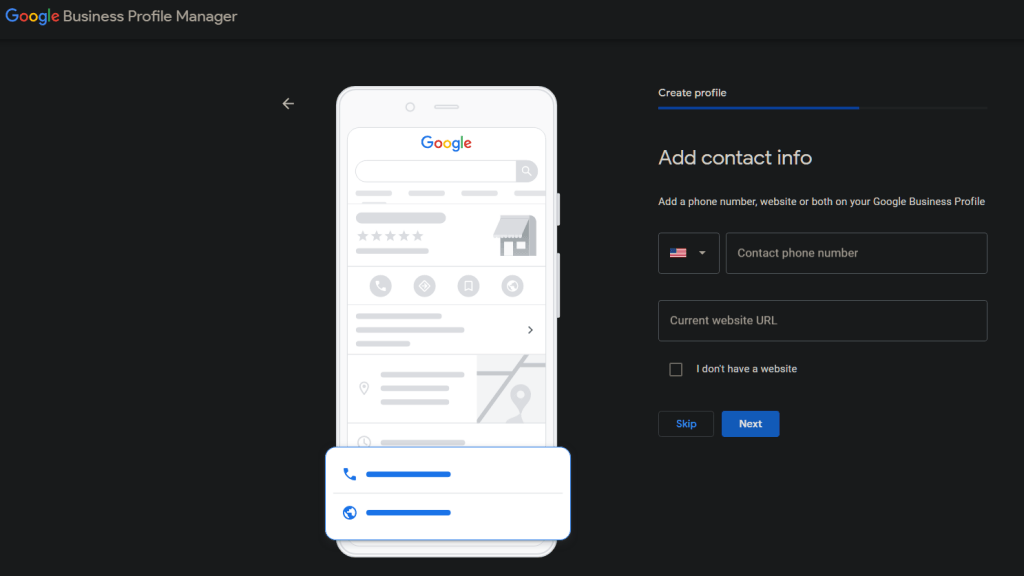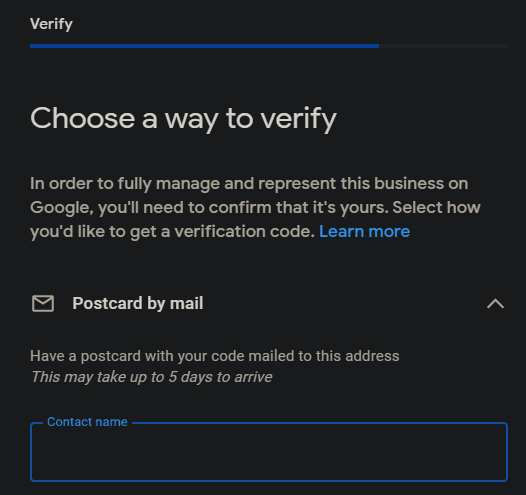Quick Note: In the past, Google has changed how this works and the naming scheme. At one point it was called Google Local, it was also once a part of the Google Plus+ ecosystem, but now it has all been de-coupled and separated into just Google Business Profile.
In this guide, we will explain how to rank in Google Maps so you can give yourself an edge against competitors. Let’s get started.
How to Create a Google Business Profile
First, head to this link and click “Manage Now”.
An important reminder: for a more professional touch, use your business domain email as your login (for example, not @gmail.com, @yahoo.com, or any other general email client).
Enter the same NAP (Name, Address, Phone Number) info that you displayed on your website and pay attention to the category section at the bottom.
Listing the correct category, which lets customers (and Google’s crawlers) know exactly what your business does, is important for displaying your business in the right search results. Google allows you to use multiple categories, so use as many as are relevant to your business. Be as specific as possible.
Next, to make any further edits to your account, you need to verify it.
There are a few ways for you to do so:
- Via postcard: Google snail mails the verification code to your listed address.
- Via phone: Google sends the verification code to your phone through an automated message.
Via email: An instant verification option, which is available if you use the same login details in your Google Search Console for your Business Profile account.
Some options may not be available, and the most popular way is to receive a postcard in the mail. Your eligibility to verify using any of the options depend on what type of business you have.
Google provides more detailed instructions for every process on its support page here.
Make sure you fill out every section possible, including uploading photos and filling out all the categories.
Google Business Profile Optimization
In a case study by BrightLocal, 84% of searches for local businesses are focused solely on discovery while only 16% are direct searches. For example, most searchers are more likely to ask something along the lines of, “bars closest to me” rather than strictly the name of your bar. Make sense?
Here are some great ways to optimize your Google Business Profile:
- Complete every section of your Google Business Profile
- Be thorough with contact information
- Add a primary category and subcategories with local keywords
- Write an entire “from the business” description
- Upload new photos weekly
- Answer questions
- Collect and respond to reviews
- Add your products and services
- Set up messaging
- Maintain your Business Profile regularly
It’s also important to optimize your information for mobile devices. In fact, 61% of mobile searches are more likely to contact a local business if their website is mobile-friendly.
Now, let’s explore some other tips on how to rank in Google Maps:
Build Backlinks
Backlinks are one of the top local search ranking factors. The more high-quality backlinks to your website that you have, the better your chances are of ranking higher and getting on Google Maps local listings.
So, what exactly are backlinks? It’s a pretty simple concept, it’s just a hyperlink that is on a different website other than your own but it ends up linking back to your landing or homepage, or even just a piece of content.
So, here are some ways to get backlinks for your website:
- Reach out to other websites and explain how linking to your website can add value to theirs
- Create High-Quality Content
- Use Infographics to Get Backlinks
- Write Testimonials
You can begin by looking for top referral sources for your website. These are sites that are already linking to your content and offering you a backlink.
By finding out what kind of websites link to yours and the type of content that they prefer, you can find new backlinking opportunities and create content that your audience already likes.
Build Niche Local Business Citations
Local citations are mentions of your business’ name, address, and phone number on any platform including social media. While most NAP citations have basic information, some of them contain extra information about the business which can provide additional authority to your website.
Niche citations are built on platforms that are specific to your niche. For example, if you run a restaurant, then your profile on Grubhub can be considered a niche citation because it’s placed on a platform that is all about food. Niche citations can help search engine crawlers associate your business with niche industries.
If you use a high-authority website to help you build your citations, you can also increase your overall online presence and boost your brand awareness.
Optimize Your Website Homepage
Your homepage should clearly express what your company does, who you are, and what you do. It’s also important to make it easy for Google to crawl and index your website.
If Google doesn’t know what your business is all about and what you offer, how can they recommend you to their users? It’s important to prove to Google that your website is worth exploring and showing.
If you’re using WordPress to build up your website, then you can easily update your page’s title tags. You can also load up your metadata via the Yoast plugin. This can help with relevant searches and is a good addition to your local SEO strategy.
Yoast can help you optimize your headings, titles, and other on-page SEO. This helps Google rank you, thus putting your website on Google’s local pack as well.
On-Page Relevance
Relevance is the consistency of a user’s request with information on a page or even a whole website. On-page SEO refers to the elements of SEO that you’re able to control on a website or webpage.
It includes any metadata or code that you control on your website itself (headers, title tags, etc.).
Google Reviews
Google states that Google review count and score are all taken into consideration when ranking for local SEO. Google uses three broad categories to help rank for Google maps.
These are:
- Relevance
- Distance
- Prominence
Search engines are basically just trying to do the same thing that users are doing, trying to find the right product, service, or information in a quick, effective manner. Reviews for businesses help Google achieve this.
So, how can you help Google do this and how can you get reviews for your business?
Provide links that make it easier for customers to write a positive or negative review. Always answer your reviews in a basic customer service fashion. Offer guidance, help, refunds, anything that makes your business appear professional and helpful.
Now You Know How to Rank in Google Maps!
Local businesses already have to manage a huge variety of SEO strategies, and Google Maps is no exception.
Especially if you haven’t verified your Google Business Profile yet. Not only do you need to hire someone who knows how to do local SEO, but you also need to make sure that your website is all set for traditional SEO as well.
If you’re feeling a bit overwhelmed, that’s totally okay, we go for you!
Sign up for free and take a look at our free SEO tools and resources.
If you’re still struggling, book a call with one of our SEO experts for advice and consolation!







